1849 – Preview and Interview
by Ian
|
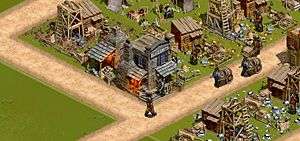 The American Wild West is a largely untapped goldmine for gaming. A few standout hits such as Red Dead Redemption aside, the golden age of revolvers, horse riding and wide-brimmed hats has mostly been passed over in favour of yet another zombie game. Thankfully, 1849, a city management game soon to be released on PC and tablets, is here to redress the balance. Set during the California Gold Rush, 1849 is a city management game in the mould of classics such as Sim City and Civilization.
The American Wild West is a largely untapped goldmine for gaming. A few standout hits such as Red Dead Redemption aside, the golden age of revolvers, horse riding and wide-brimmed hats has mostly been passed over in favour of yet another zombie game. Thankfully, 1849, a city management game soon to be released on PC and tablets, is here to redress the balance. Set during the California Gold Rush, 1849 is a city management game in the mould of classics such as Sim City and Civilization.
This heritage is keenly felt even in the preview code that we were provided, with a very structured system of resource generation leading to city growth, which in turn led to increasing demands on resources. This snowball effect is what keeps the game running, and it is in managing the details of this cycle that the challenge lies. From my taste of the game (which was a beta build, before sound had been implemented), it did, at this stage, feel a little like a fairly generic city builder with a lick of Western-themed paint. When I put this to the developer, SomaSim, they talked about how the “Gold Rush was the driver for just about everything in the game. All of the art is based either on photos from the 1850s or from surviving structures. All of the cities in the game played a role in the Gold Rush, and the scenario progression takes you through the opportunities and difficulties of the different locations.”
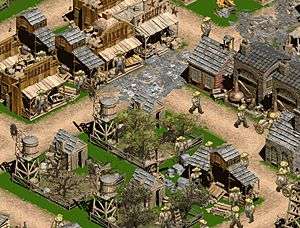 The setting, then, is intended to be the centre of the experience. Initially, it struck me that the game-type was a slightly odd choice of genre for the era – the Wild West is famous in my mind for cowboys, horse-back gun battles and rootin’-tootin’ fun. However, on further questioning, the marriage between game and theme starts to make sense. As explained by SomaSim, “the resource management mechanics are based on the settlers streaming in with the dream of striking it rich, and the infrastructure that had to be created and managed in order to support them.” When taken from this angle, 1849 is pitched brilliantly – who mined the metal to make the guns for the cowboys? Who produced their food and built their homes? You did, that’s who.
The setting, then, is intended to be the centre of the experience. Initially, it struck me that the game-type was a slightly odd choice of genre for the era – the Wild West is famous in my mind for cowboys, horse-back gun battles and rootin’-tootin’ fun. However, on further questioning, the marriage between game and theme starts to make sense. As explained by SomaSim, “the resource management mechanics are based on the settlers streaming in with the dream of striking it rich, and the infrastructure that had to be created and managed in order to support them.” When taken from this angle, 1849 is pitched brilliantly – who mined the metal to make the guns for the cowboys? Who produced their food and built their homes? You did, that’s who.
Graphically, 1849 is presented from a classic isometric view. Sprites and buildings have a charming, hand-drawn aesthetic, and animation, while simple, fits perfectly with the lives of your settlement’s day to day existence. Citizens wander from home to work, workers wheel carts full of goods to the central warehouse, and the sheriff lazily slings his rifle over his arm as he keeps his eyes on everything going on. While the graphics are appealing in a classic, hi-res 16-bit kind of way, they clearly appear to be designed with mobile in mind. Aside from a few levels of zoom, the viewpoint is fixed, and buildings cannot be rotated in any way. SomaSim have said that they “wanted to make a game that’s a first-class citizen across multiple platforms, that can be played just as well on a dedicated PC desktop, as on a smaller laptop when traveling, and also on a tablet while watching TV or commuting.” The graphical choices made by the team are “a nod to the classics of the genre, such as Caesar III and other Impressions games”, but also admit that mobile is forefront in the mind when designing, as “mobile is the most exacting of these platforms, in terms of how little processing power is available to drive high-resolution displays, [which] shaped a number of our technical decisions.”
The flow of gameplay is reasonably simple to understand. Houses need to built for prospectors to move in to. This generates rent, which allows you to then buy and place various buildings – resource generators such as farms and vineyards, resource converters such as bakeries or wineries, and utilities such as a Sheriff’s office or a saloon. Buildings can be upgraded – houses upgrade automatically when enough resources are available, and other buildings can be upgraded by the user when enough currency is available. The enjoyment and challenge that I found came from balancing having enough residents and workers to fill the jobs that were created, without either having too many unemployed people around, or running out of money to provide jobs. It is, ultimately, a simple formula, but keeping all of the different plates spinning can become very difficult once the settlements start growing.
 A major concern that I had, especially with the game being developed for mobile, was in the resource meta-game. Some resources cannot be generated by the player in certain scenarios, but they are required, nevertheless, for house growth, or to meet the requirements of optional telegrams that pop up from time to time. In these cases, resources can be acquired by trading with other settlements, which often comes with a hefty cost in opening the trade route in the first place, before further currency is spent on actually procuring the goods needed. To me and my cynical mind, especially in the current climate of in-app purchases being shoe-horned in to all kinds of games, this mechanic seemed ripe for exploiting the player through micro-transactions. Thankfully, despite the developers’ previous life with Zynga, this absolutely not the case. When asked if this trading sub-game was designed with in-app purchases in mind, SomaSim responded firmly:
A major concern that I had, especially with the game being developed for mobile, was in the resource meta-game. Some resources cannot be generated by the player in certain scenarios, but they are required, nevertheless, for house growth, or to meet the requirements of optional telegrams that pop up from time to time. In these cases, resources can be acquired by trading with other settlements, which often comes with a hefty cost in opening the trade route in the first place, before further currency is spent on actually procuring the goods needed. To me and my cynical mind, especially in the current climate of in-app purchases being shoe-horned in to all kinds of games, this mechanic seemed ripe for exploiting the player through micro-transactions. Thankfully, despite the developers’ previous life with Zynga, this absolutely not the case. When asked if this trading sub-game was designed with in-app purchases in mind, SomaSim responded firmly:
“Absolutely not. I had been working on freemium games for the previous six years, at Zynga and at Three Rings before that, and I understand the benefits – but there are also serious drawbacks. The decision to go with freemium is not without consequences, and it’s a mould that constrains your design and shapes it in ways that you sometimes might not expect. We didn’t think the freemium mould was appropriate for our game. 1849 is a management simulation with mechanics that are tied together and interconnected like gears in a watch, and if you tried to take one or two pieces out to sell separately, the whole machine would just fall apart. It makes no sense to apply that model to this kind of a game. Instead, we wanted a game experience that stood on its own: you buy a box with all the gears at once, and you build various machines out of them. We’ll develop more scenarios as DLC packs to layer on top of that core game, but have no plans to segment out the core features or gameplay and charge players incrementally. So there will be no infuriating timers, no gem packs, no resource microtransactions, none of that stuff. Is this a foolish idea? Possibly. We’ll find out in a few months, when the game is out.”
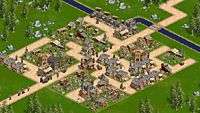 |
 |
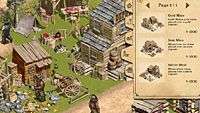 |
With this reassurance, the trading for resources aspect of 1849 lends an extra layer of strategy to proceedings, which will lend depth to a game that initially appeared a little thin. Admittedly, I only played the few scenarios that were presented to me in the preview code – free-play was not an option yet – but I was already feeling like I’d experienced all that I could. SomaSim promise that things will ramp up though, as “the game starts with a rather simple tutorial, but complexity builds as players are tasked with increasingly dense cities and intricate economies.” This build-up is intended to mirror the era, as “the Gold Rush itself started out with a few prospectors panning for gold in streams, but after a few years it really got going with industrial mining and huge boomtowns.”
1849, then, is a promising cross-platform take on the city-management genre. It is currently available through early access open beta, either through Steam or IndieGameStand, with a final release date of early May currently in mind.
Last five articles by Ian
- Shooting Stars - Review
- Sora - Review
- Early Access - Epistory, Ironkraft, and Zombasite
- 1849 - Preview and Interview
- Diablo III: Reaper of Souls - Review

















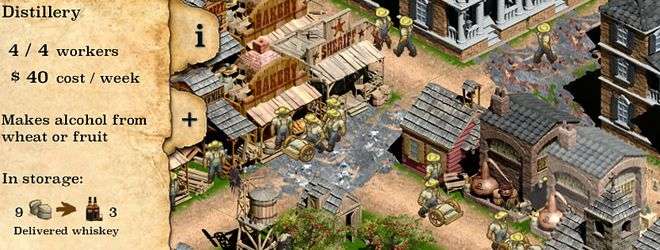





There are no comments, yet.
Why don’t you be the first? Come on, you know you want to!